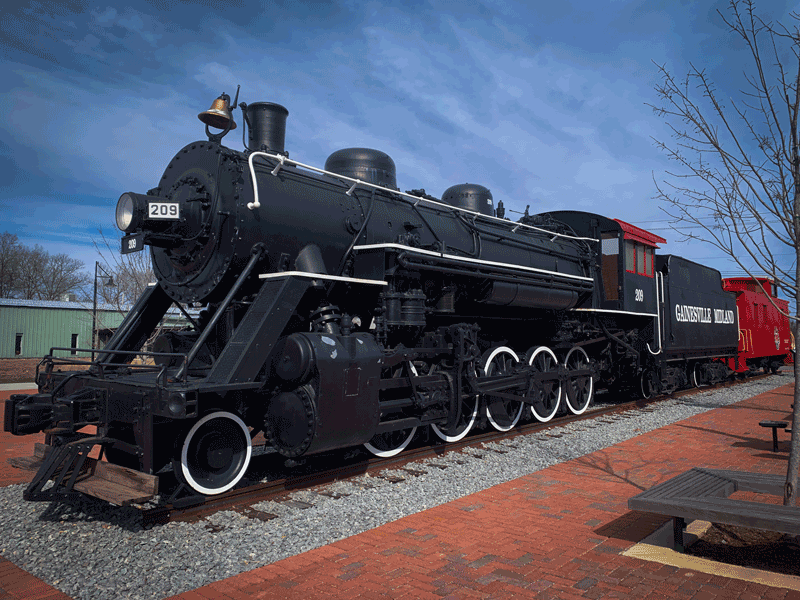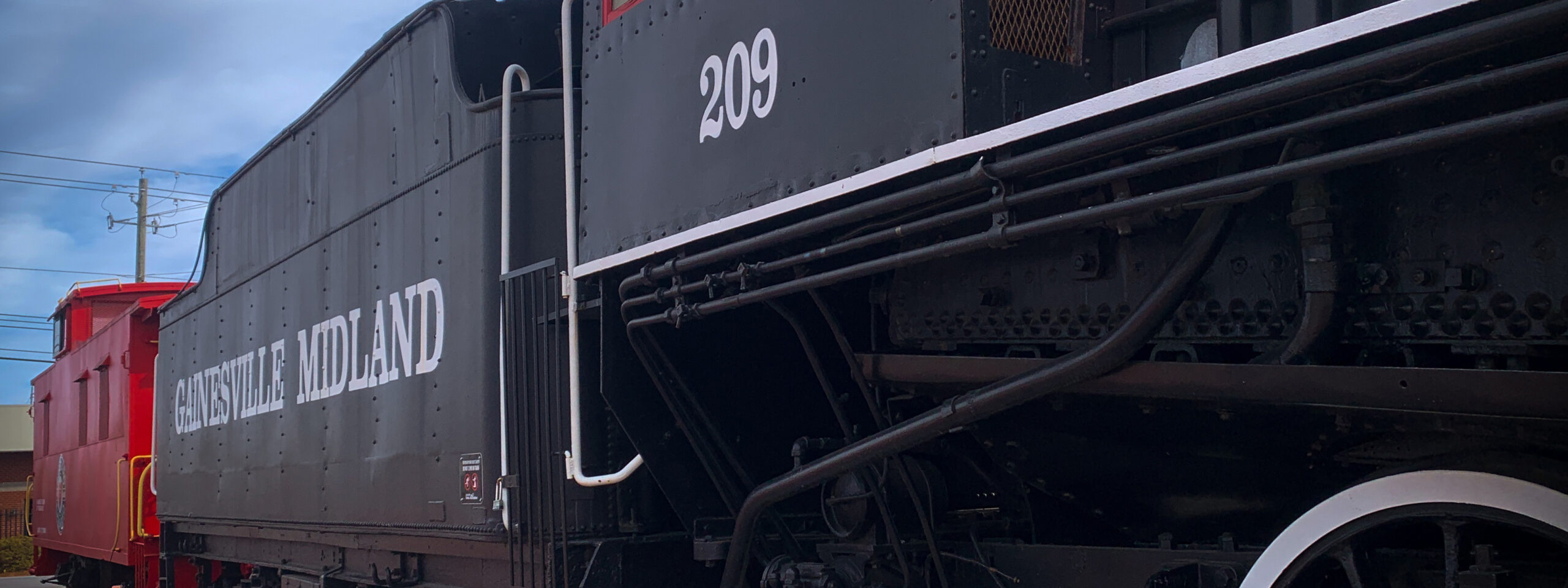As you head northeast from Atlanta and enter Gwinnett County, you see the massive growth in areas like Duluth and Buford. Keep going a bit further north, and then a bit further east, and you encounter a chain of communities that were once a half-day wagon ride apart until the railroads came and created the connectivity that would shape the future of North Georgia. Journey along as we explore these historic railroad towns.
Beyond Buford, winding through the map dots to the Classic City of Athens, the landscape of North Georgia tells its story across miles of both dormant and well-traveled railroad tracks, in its deep agricultural roots, and through the flourishing of myriad industries. These towns, each with their unique stories, stand as a network of economic silos, contributing to Georgia’s impressive annual GDP of $756 billion.
Let’s walk together, down the proverbial red dirt road, and explore the origins, growth, and real estate scenes of these charming railroad towns.
Gainesville: Gateway to the Mountains
In the early 1800’s, Gainesville, originally named “Mule Camp Springs,” transformed into a thriving town. Renamed in 1821 to honor General Edmund P. Gaines, the arrival of the Richmond and Danville Railroad in 1871 (later known as the Georgia Southern Railroad), propelled the town’s growth from 1,000 residents in 1870 to over 5,000 by 1900. Textile mills flourished, relying on the railroad for the transportation of raw materials and finished products.
In the 1920s, Gainesville native Jesse Jewell ushered in the poultry industry and revolutionized its processes. This eventually made Gainesville the “Poultry Capital of the World,” with a staggering annual industry value of $1 billion. Today, international firms like Kubota Manufacturing and ZF Wind Power call Gainesville home. With its vital positioning near I-985 and I-85, it’s no wonder Gainesville has been recognized as one of Georgia’s fastest-growing cities of the twenty-first century.
 Photos: KJ Jones
Photos: KJ Jones
Real Estate Snapshot:
Gainesville’s real estate market mirrors its diverse economy, offering everything from historic homes to modern developments, robust apartments, and lake-front condominium options. With a thriving poultry industry, the area’s largest hospital network, and various amenities, Gainesville attracts a wide range of homebuyers.
Gainesville Median Home Price: $349,124 | Gainesville Market Report
Flowery Branch: Steeped in History and Natural Beauty
Flowery Branch was founded in 1874 under the name Anaguluskee and it still whispers tales of the Cherokee people with that original moniker. The meaning? “Flowers on the branch.” The town’s story unfolds not as that of a lake-side burgh—Flowery Branch precedes the existence of Lake Lanier by nearly a century—but tells of a place that has witnessed the valley’s transformation into the scenic recreational mecca we now know.
Flowery Branch’s past is steeped in resilience and historic significance. Settled along the Old Federal Road, Anaguluskee has borne witness to crucial chapters of our country’s history, including the Trail of Tears, passage of Confederate and Union troops during the Civil War, and the Georgia Gold Rush. Amidst these historical events, the late 1800’s brought the arrival of the railroad, granting newfound prosperity to local farmers and merchants who could now ship their wares with ease.
Today, Flowery Branch beckons seekers of a harmonious lifestyle, drawing them in with its picturesque location that offers views of Lake Lanier, the mountains, and the siting of an occasional NFL player or actor—Flowery Branch is home to the Atlanta Falcons Training Camp and also serves as a popular filming location. The town provides a seamless blend of nature, history, and modern appeal.
Real Estate Snapshot:
In the real estate market of Flowery Branch, homes reflect the town’s allure, with waterfront properties and charming residences creating a vibrant community mosaic. The addition of lake properties elevates desirability, contributing to a median home price that reflects the intrinsic value of living in this beautiful and historic little haven.
Flowery Branch Median Home Price: $496,000 | Flowery Branch Market Report
Oakwood: Where the Oaks and Railroads Converge
Originally called Odell’s Crossing when it was founded in 1873, the town’s name officially changed to Oakwood with its incorporation in 1903. This new name was derived from the lines of oak trees that stood sentinel along the railroad tracks and, ultimately, for supplying the wood that fueled locomotives. As a bustling railroad center that served as a regular stop between Atlanta and Charlotte, the town blossomed, becoming a hub for industries that paved the way for its business success even today.
Beyond its legacy as a center for commerce and industry, Oakwood boasts a sterling reputation for its educational opportunities in North Georgia. Families with school-age students enjoy an excellent public school system and the University of North Georgia (formerly Gainesville College) attracts scholars from across the country.
Inspired by the town’s history as a transportation and commercial hub, Oakwood city leaders have prepared for future community and economic growth with the construction of a four-lane commercial parkway that runs parallel to the I-985 corridor. The new Thurmond Tanner Parkway allows for easy access to Oakwood’s industrial, cultural, and educational destinations.
Real Estate Snapshot:
Proximity to educational institutions and job opportunities in neighboring towns infuses diversity into Oakwood’s real estate market, offering an array of housing options sure to fit nearly every budget.
Oakwood Median Home Price: $299,890 | Oakwood Market Report
Braselton: A Legacy of Commerce and Reinvention
With the establishment of their 796-acre farm in 1876, William H. Braselton, Sr., and Susan Hosch Braselton laid the foundations of a now-historic town that burgeoned with the arrival of the railroad in 1902 and a state highway in 1927. Marrying their agricultural upbringing with commerce, William and Susan’s sons, John Oliver, Green, and William Henry (later known as Braselton Brothers, Inc.), pioneered the town’s economic landscape with a mercantile and grocery business, a grist, and a flour mill.
A precursor to today’s shopping malls, the Braselton Brothers Department Store provided a one-stop shopping venue that also housed the town’s post office and freight depot, among other community resources. Today, the historic store building has been refurbished and houses a variety of local merchants.
Economic challenges in the mid-1900s led to a decline and a wild ride for the little town. At one point, Braselton was owned by actress Kim Basinger who had hoped to turn it into a tourist destination. In the 1990s Braselton’s revitalization was greatly influenced, if not spearheaded, by entrepreneur Don Panoz.
Panoz’s strategic planning and visionary leadership brought about the establishment of the Chateau Elan Resort and Winery, which transformed Braselton into a thriving community with an elevated status. This revitalization extended to Road Atlanta, recognized today as a world-class motorsports facility.
Real Estate Snapshot:
Braselton’s real estate market caters to various preferences, offering historic homes, exclusive communities, and modern residences.
Braselton Median Home Price: $495,985 | Braselton Market Report
Winder: A Journey Through Time and Tranquility
Winder—originally an Indian settlement known as Snodon, then called Jug Tavern by white settlers, and eventually named Brandon—began its recent historical journey as a colonial trading center. By 1893, the town had evolved into a crucial railroad link between Athens and Atlanta and was incorporated with the name “Winder” to honor John H. Winder, president of the Seaboard Air Line Railroad.
By the turn of the twentieth century, Winder’s boundaries extended into three counties: Jackson, Walton, and Gwinnett. To resolve the inevitable governance challenges this caused, Governor John M. Slaton’s 1914 constitutional amendment created Barrow County with Winder as its county seat. The Gainesville Midland Railroad and the Georgia, Carolina, and Northern Railway intertwined with the town’s growth, giving birth to historic districts like Broad Street and the Barrow County Courthouse.
Today, residents and visitors enjoy Winder for its history, culture, and abundance of outdoor recreation opportunities. Located just one mile south of town, Fort Yargo State Park is a popular destination for nature lovers as well as history buffs. The original fort, built by settlers in 1792 to withstand Creek and Cherokee Indian attacks, stands as a testament to Winder’s resilience and its storied past.
Real Estate Snapshot:
Winder’s real estate landscape mirrors its historical richness, ranging from Southern charm in historic homes to modern developments. The town’s affordability and mix of residential styles make it appealing to those seeking a tight-knit community with a blend of historical and contemporary living options.
Winder Median Home Price: $385,985 | Winder Market Report
Commerce: Where History and Trade Intersect
Long before European settlement in the early 1800s, the area today known as Commerce already was rooted in the business of trade and travel thanks to The Lacoda Trail. Once the community was established under the name Harmony Grove in 1818, it took only a few short decades for the town to become known for its successful cotton market. By the time the North Eastern Railroad (owned by Norfolk Southern Railroad today) arrived in 1876, the town was well poised for the expansion of its geographic boundaries as well as its elevated status as a major player in the textile market.
Today, the town stands as a testament to its name, fostering a balance between business and community. Commerce’s history is on display throughout town, reflecting its evolution from early trade, through the Civil War, to its development into a manufacturing and business hub. Historic districts showcase the cultural and architectural heritage that defines Commerce.
From historic mills to modern enterprises, to the railroad that still runs through the heart of downtown, Commerce’s industrial landscape contributes to the economic fabric of North Georgia. The town’s industrious spirit remains.
Real Estate Snapshot:
Commerce’s real estate offers a mix of tradition and modernity. Historical homes coexist with contemporary developments, providing diverse housing options situated within easy driving distance of big-city amenities.
Commerce Median Home Price: $320,000 | Commerce Market Report
This is a small sampling of North Georgia towns and communities that were materially changed by the railroad. The echoes of history and the hum of progress intersect to not only celebrate the past but also embrace the present and future. Each town contributes to the diverse and dynamic story of North Georgia.
The real estate market in each town reflects the ongoing evolution and appeal of North Georgia. For a closer look at each market, feel free to explore the provided links and immerse yourself in the distinctive charm and opportunities that Gainesville, Flowery Branch, Oakwood, Braselton, Winder, and Commerce offer. These towns, with their unique blend of tradition and modernity, stand as testaments to the enduring allure of North Georgia’s railroad legacy.


0 Comments